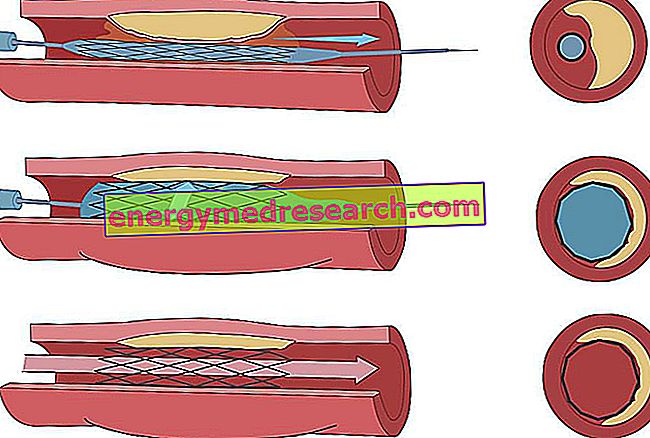Generality
Amenorrhea is the absence of menstruation, in women of childbearing age. Distinct in primary and secondary, it can depend on numerous factors; in fact, one of the main causes of amenorrhea includes: pregnancy, menopause, the use of specific drugs, anorexia nervosa, bulimia, malnutrition, excessive stress, drug use, pituitary tumors or hypothalamus, Sheehan's syndrome, Turner's syndrome and anatomical abnormalities of the female genital tract.

An accurate diagnosis of amenorrhea makes it possible to establish the precise causes.
Knowledge of the causes of amenorrhea is the starting point for planning the most appropriate treatment.
The prognosis depends on the severity of the triggering condition.
Brief review of the hypothalamus axis - pituitary - ovaries
In a woman with a regular menstrual cycle, the hypothalamus, pituitary gland, ovaries and uterus function properly:
- Through a specific hormone, called GnRh, the hypothalamus stimulates the pituitary gland to produce the so-called gonadotropins FSH (or follicle-stimulating hormone) and LH (or luteinizing hormone);
- Once secreted, the FSH and LH gonadotropins reach the ovaries through the bloodstream, stimulating them to produce the hormones estrogen and progesterone ;
- Estrogens and progesterone have the task of regulating the various passages of the menstrual cycle, from the release of the follicle to the exfoliation of the endometrium and the appearance of menstruation.
What is amenorrhea?
Amenorrhea is the medical term that indicates the absence of menstruation, in women of childbearing age.
TYPES OF AMENORREA
Doctors recognize the existence of two types of amenorrhea: primary amenorrhea and secondary amenorrhea .
By primary amenorrhea, they mean all cases of amenorrhea in female subjects who, at the age of 16, have not yet had menarche (first menstruation), but have developed all secondary sexual characteristics (breast, pubic hair, etc. ) and all cases of amenorrhea in female subjects who, at the time of their 14th birthday, have not yet had a menarche and have not yet developed any secondary sexual character.
For secondary amenorrhea, instead, the doctors mean the absence of menstruation for at least three months, in a woman who previously had never suffered from irregularities in the menstrual cycle, and for at least nine months, in a woman with a past history of oligomenorrhea .
Oligomenorrhea is the medical term for the non-regularity of menstruation in women of childbearing age.
Causes
The causes of amenorrhea are numerous.
In fact, amenorrhea can depend on:
- Natural conditions . Among the natural conditions that can cause amenorrhea are pregnancy, breastfeeding and menopause;
- The use of contraceptives . The absence of menstruation from contraceptive use concerns only a part of women. In these situations, the return to normality (therefore the recovery from amenorrhea) occurs when the subjects concerned stop using contraceptives.
- Taking certain medications . Among the medicines that can cause amenorrhea, we mainly report: antipsychotics, chemotherapy (ie drugs for chemotherapy), antidepressants, drugs for controlling blood pressure and drugs for allergies.
- Special lifestyles or habits . Among the lifestyles or habits that can determine amenorrhea, they deserve a mention: the excessive weight loss due to conditions such as anorexia nervosa or bulimia, severe obesity, excessive practice of physical exercise, the excess stress and drug abuse (eg, heroin, cocaine, etc.).
- Hormonal imbalances, due to anomalies of the hypothalamic-pituitary-ovarian axis . Different conditions can lead to hormonal imbalance along the hypothalamic-pituitary-ovarian axis, including: pituitary tumors (eg craniopharyngioma) or hypothalamus, Kallmann syndrome, Turner syndrome, severe nutritional deficiencies, Sheehan's syndrome, gonadal dysgenesis and polycystic ovary syndrome (or polycystic ovary).
- Hormonal imbalances, not dependent on the hypothalamic-pituitary-ovarian axis . Hormonal imbalances not due to anomalies of the hypothalamic-pituitary-ovarian axis may derive from thyroid malfunction (hypothyroidism and hyperthyroidism), Cushing's syndrome, prolactinoma episodes, etc.
- Anatomical anomalies of the female genital apparatus . The anatomical abnormalities of the female genital tract that can induce amenorrhea include: the uterus with scars ( Asherman's syndrome or intrauterine adhesions), total or partial absence of the uterus, lack of the vagina (atresia or vaginal agenesis) and malformations of the vagina (transverse vaginal septum, etc.).
- Other causes . Other possible factors triggering the amenorrhea are: radiotherapy for the treatment of tumors, galactosemia, sarcoidosis, fragile X syndrome (or the presence of a fragile X premutation), depression and psychiatric disorders in general, tuberculosis etc.
Examples of causes of primary amenorrhea
- Turner syndrome
- Fragile X syndrome
- Kallmann syndrome
- Congenital anomalies of the genital system
Examples of causes of secondary amenorrhea
- Pregnancy
- Menopause
- Polycystic ovary syndrome
- Breastfeeding
- Use of contraceptives
- Asherman syndrome
- Sheehan syndrome
- Excessive stress
- Excessive physical activity
- Nervous anorexia
- Bulimia
- Hyperthyroidism
- Hypothyroidism
Symptoms, signs and complications
The sign that distinguishes the presence of amenorrhea is the lack of blood loss, by women, at the time of menstruation.
ASSOCIATED SYMPTOMS
The presence of amenorrhea is often accompanied by other symptoms and signs.
Symptoms and signs that most frequently accompany amenorrhea include:
- Headache;
- Vision disorders;
- Excessive growth of facial hair (hirsutism);
- Acne;
- Pelvic pain;
- Vaginal dryness;
- Hair loss;
- Abnormal leakage of milk from the breast (galactorrhea);
- Hot flashes and night sweats;
- Sleep disorders;
- Clear increase or reduction in body weight.
WHEN TO REFER TO THE DOCTOR?
For investigations, they should contact their doctor: all women who have been complaining of menstruation for the first time for at least three months; all women with a history of oligomenorrhea, who have been complaining of menstruation for at least nine months; all women who, at the age of 16, have not yet had their first menstruation despite having long developed secondary sexual characteristics; finally, all the women who, at the age of 14, have not yet had their first menstruation and have not yet developed secondary sexual characteristics.
Diagnosis
When they talk about the diagnosis of amenorrhea, the doctors mean not only the finding of the absence of menstruation, but also and above all the identification of the triggering causes ( causal diagnosis ).
Moreover, knowledge of the causes of amenorrhea is the starting point for planning the most appropriate treatment.
HOW TO SEARCH FOR CAUSES
The diagnostic procedure for identifying the causes of amenorrhea may include:
- An investigation of the symptoms that accompany the absence of menstruation;
- A pelvic exam;
- An examination of the breast and genitals;
- A pregnancy test, to see if the patient is pregnant or not;
- Blood tests, aimed at quantifying the hormone levels of FSH, LH, TSH and prolactin;
- An ultrasound of the pelvis. Doctors prescribe it with the intent to observe the anatomy of the internal genital organs. An ultrasound of the pelvis allows to detect several anatomical anomalies;
- A CT and / or nuclear magnetic resonance of the head. Both painless, they provide very significant images of the internal anatomical structures of the head. Doctors could prescribe them if, based on the symptoms reported by the patient, they suspect hypothalamus or pituitary tumors. Compared to nuclear magnetic resonance, CT has the advantage of showing some more details and the disadvantage of exposing the patient to a non-negligible dose of ionizing radiation;
- Hysteroscopy and / or hysterosalpingography. The first is, in fact, an endoscopic ultrasound examination of the uterus. The second, instead, is a radiological examination of the uterus and fallopian tubes. In general, doctors use them if the pelvic exam and pelvic ultrasound have been limited and clarifying.
Therapy
To treat the amenorrhea, doctors must focus on the proper treatment of triggers . It follows that amenorrhea therapy varies from patient to patient, depending on what triggered the absence of menstruation. This explains why the doctors consider the causal diagnosis to be essential.
SOME EXAMPLES OF TREATMENT FOR AMENORREAS
Below are some examples of amenorrhea therapy. This is a general overview, which shows how, in some cases, the treatment is very simple, while, in other situations, it is very complex and of uncertain outcome.
- In the presence of amenorrhea due to an excessive drop in body weight, the treatment includes the planning of a diet aimed at gradually restoring the normal body weight.
It should be pointed out that, if the excessive drop in body weight is due to a disturbance in eating behavior (anorexia nervosa, bulimia, etc.), psychotherapy is also essential.
- In the presence of amenorrhea due to excessive physical activity, the treatment is very simple and consists in reducing the number of hours dedicated to physical exercise;
- In the presence of amenorrhea due to taking a certain drug (antidepressant), the treatment consists in interrupting the use of the aforementioned drug;
- In the case of amenorrhea due to an excessive increase in body weight, the treatment includes a slimming diet and the constant practice of physical activity, also aimed at weight loss;
- In the case of amenorrhea due to too much stress, the treatment involves the use of relaxation techniques;
- When the amenorrhea is a consequence of a pituitary tumor, the treatment is surgical and consists of the delicate removal operation, from the pituitary gland, of the tumor mass;
- In the case of amenorrhea resulting from intrauterine adhesions, the treatment is surgical and consists of the removal of scar tissue from the uterus;
- In the presence of amenorrhea following the polycystic ovary, the therapy is of a pharmacological type and involves the administration of medicines, such as: the contraceptive pill, the progesterone derivatives and the clomiphene.
- In the presence of amenorrhea resulting from abnormalities of the genital tract, the therapy is surgical and consists in restoring, where possible, the normal anatomy of the organs involved.
Prevention
We can talk about the prevention of amenorrhea only for those cases dependent on avoidable or controllable causes, such as malnutrition, anorexia nervosa, excessive physical activity, obesity or excessive stress.
Prognosis
The prognosis in case of amenorrhea depends on the triggering factors: if a cause is successfully curable, the chances that the amenorrhea has a favorable prognosis are considerable; vice versa, if a cause is hardly treatable (because, for example, it is particularly serious), there is a non-negligible probability of an unfavorable prognosis.



